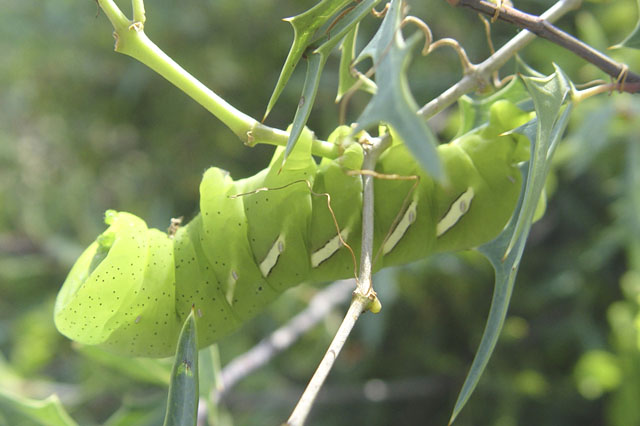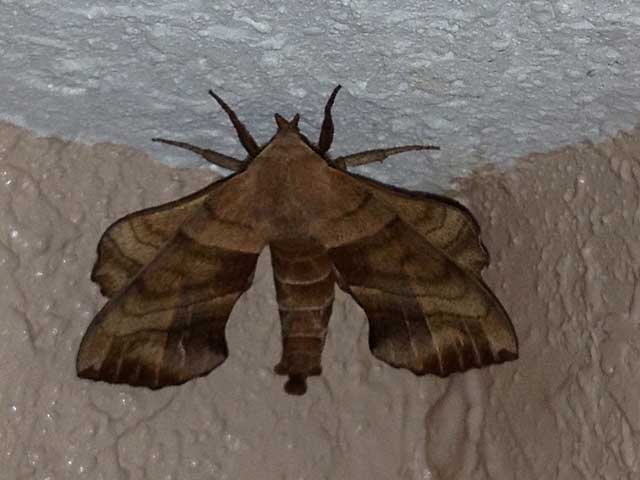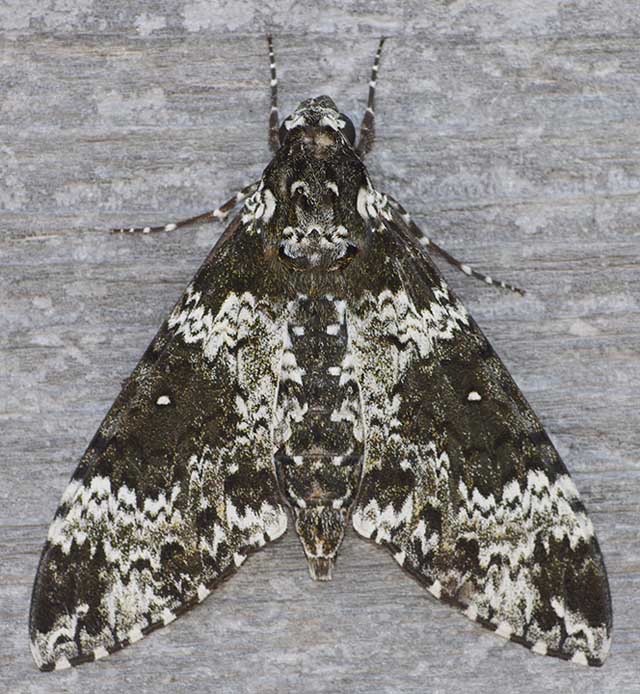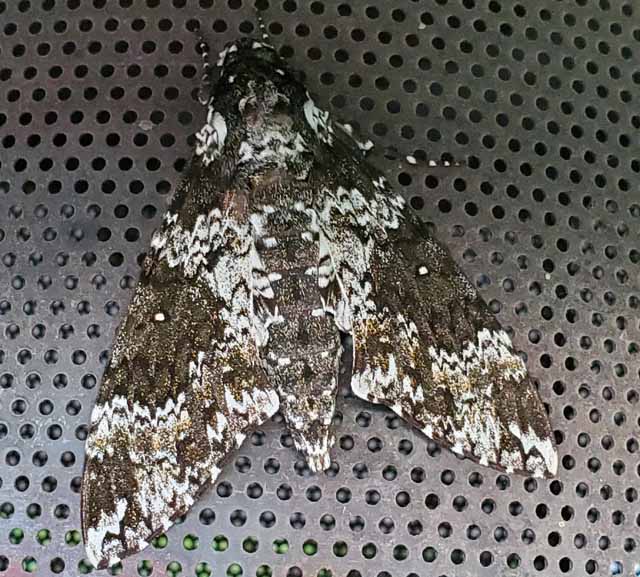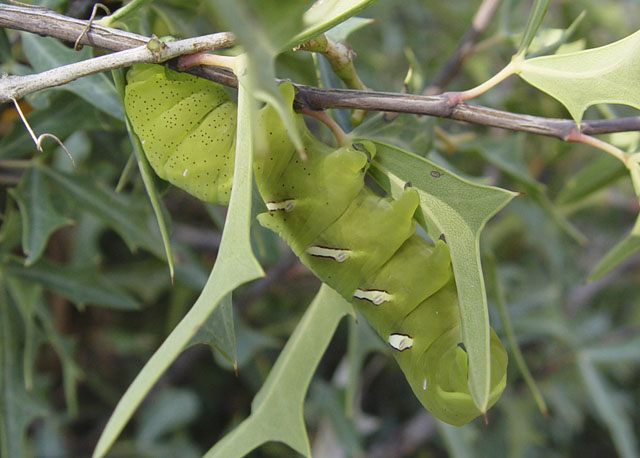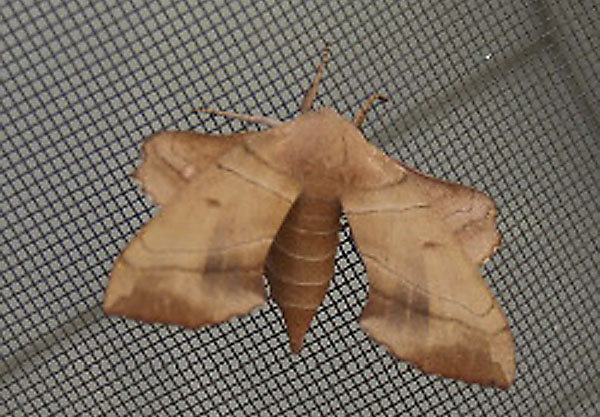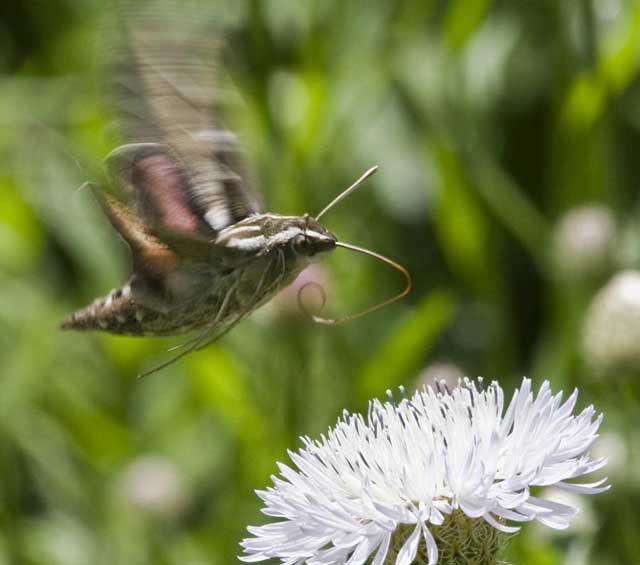Sphinginae subfamily
Sphingini tribe:
 |
Agrius cingulata,
USGS Pink-spotted hawkmoth.
This species is a strong migrant and adults nectar from
deep-throated flowers including moonflower (Calonyction aculeatum),
morning glory (Convolvulus), honey suckle (Lonicera)
and petunia (Petunia species).
|
 |
Ceratomia amyntor
USGS,
the Elm Sphinx or Four-horned Sphinx.
The upperside of the forewing is brown with dark brown and white markings including a white costal area near the wing base, dark streaks along the veins,
and a white spot in the cell.
Larvae feed on Elm (Ulmus), birch (Betula), basswood (Tilia), and
cherry (Prunus). |
 |
The upperside of the forewing is yellowish brown with no white markings, but there are indistinct black lines and dashes. The cell spot is gray with a black outline. The larvae feed in large groups and are much more
spectacular than the moths.
Catalpa is the larval host.
generally more eastern species |
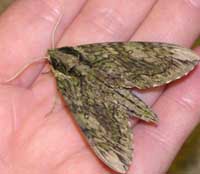 |
Ceratomia hageni
WO,
Hagen's Sphinx or Osage Orange Sphinx
The upperside of the forewing is gray with a green tint and has dark
indistinct wavy lines, and pale gray patches at the wing tip and
along the costa. generally more eastern species |
 |
Ceratomia undulosa
USGS, the Waved
Sphinx:
The upperside of the forewing is pale brownish gray with wavy black
and white lines and a black-outlined white cell spot. The upperside
of the hindwing is gray with diffuse darker bands. |
Michael van Buskirk comments on Ceratomia undulosa
from Bexar County. "I have learned to find the larvae with relative
ease along creeks on the local Fraxinus berlandieriana
(Mexican Ash) saplings. I see two broods--one in March-May, and the
other in September-November. The June-August time is so hot and humid
that I wonder (no real data to back this up) if the spring pupae wait
until it cools off in September to emerge. My hunch is that many of
the Sphingids use this strategy here."
 |
Dolba hyloeus
WO/MVB/AG, the Pawpaw Sphinx
The upperside of the forewing is dark brown with a dusting of white
scales. Some moths have patches of reddish or yellowish brown on the
wings. generally more eastern species
|
Dolba hyloeus: Michael van Buskirk confirms in Bexar County,
May 2006.
Dolba hyloeus
Austin, Texas, May 13, 2008, courtesy of Rick Gentry.
Dolba hyloeus, McGregor, McLennan County, September 27, 2010, Ann Gordon.
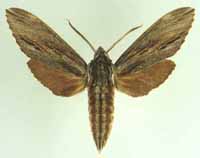 |
Isoparce cupressi
USGS, the Cypress or Baldcypress Sphinx
Isoparce cupressi, the rare Cypress Sphinx, flies in Cypress swamps in Georgia (specimen type locality), and from Maryland to Texas.
It has been reported in Mexico.
|
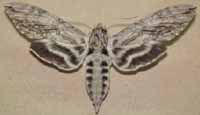 |
The upperside of the forewing is pale gray with a yellowish tint,
wavy black lines and dashes, and inconspicuous white spots.
|
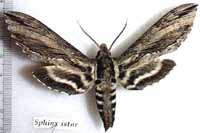 |
Lintneria istar
WO,
the Istar Sphinx.
The upperside of the forewing is dark gray with brown tinges. A
series of narrow dashes runs from the tip to the
cell spots, and a wide black band runs from the middle of the
outer margin to the base of the wing. It flies to the
east and to the south and might be present.
|
 |
Lintneria geminus
USGS,
the Gemmed Sphinx Moth: The upperside of the forewing is gray with wavy black and light
gray bands and two small gray spots near the center of the costa.
|
 |
Manduca quinquemaculatus
USGS,
the Five-spotted Hawkmoth:
I suspect if you grow tomatoes, you are likely to encounter Manduca quinquemaculata.
|
 |
Manduca rustica
USGS/AG/JM the Rustic Sphinx:
Look for three large yellow spots
on each side of the abdomen. The upperside of the forewing is
yellowish brown to deep chocolate brown with a dusting of white
scales and zigzagged black and white lines.
|
Manduca rustica, McGregor, McLennan County, August 5, 2010, Ann Gordon.
Manduca rustica, south Austin, August 2, 2012, Jackson MacLean
Manduca rustica; near Boerne City Lake, Kendall County; September 11, 2017, Dave Barker
Manduca rustica; Austin, Travis County; September 13, 2020, Bhasty
 |
Manduca sexta
USGS/AG/ER, the Carolina Sphinx
If you grow tomatoes, you have probably encountered Manduca sexta
in the larval stage.
Larvae get very large and can strip a tomato plant.
|
Manduca sexta, McGregor, McLennan County, July 1, 2011, Ann Gordon.
Manduca sexta, Lake Waco Wetlands, McLennan County, September 15, 2012, Eric Runfeldt.
 | The upperside of the forewing is gray with indistinct black and
white markings. There is a series of black dashes
from the base to the tip, and a small white cell spot.
|
Paratrea plebeja: Michael van Buskirk, Bexar County, May 2005
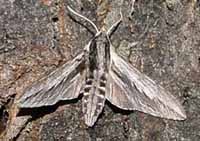 | Sphinx dollii (Wing span: 1 3/4 - 2 1/2 inches (4.5 - 6.3 cm)),
flies in arid brushlands and desert foothills from Nevada and
southern California east through Utah,
Arizona, Colorado, and New Mexico to Oklahoma and Texas.
Probably replaced by Sphinx vanbuskirki in central eastern Texas: Bexar County.
|
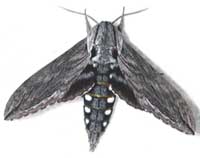 | The upperside of the forewing is pale blue-gray to dark gray with a black dash reaching the wing tip and
a white stripe along the lower outer margin.
The upperside of the hindwing is black with two diffuse white
bands, the upper one being practically non-existent.
|
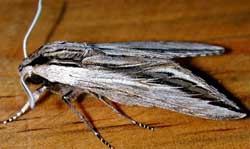 |
Sphinx vanbuskirki
Michael Van Buskirk/Jean Haxaire,
Van Buskirk's Doll's SphinxIncense Cedar Sphinx
This species is almost identical to Sphinx dollii and replaces
dollii, possibly in all of Texas, at least in eastern Texas.
|
Smerinthini Tribe:
 |
Amorpha juglandis
FS/ML/USGS/AG/FC/MA,
the Walnut Sphinx.
Highly variable; sometimes wings may be all one color or may have several colors, ranging from pale to
dark brown, and may have a white or pink tinge. Patterns range from
faint to pronounced.
Female is different. |
Amorpha juglandis: Michael van Buskirk reports them as common in Bexar County.
Amorpha juglandis, McGregor, McLennan County, July 9, 2011, Ann Gordon.
Amorpha juglandis, Salada, Bell County, September 12, 2012, Fred Colwell.
Amorpha juglandis, Priddy, Mills County, May 12, 2014, Melinda Adams.
 |
Pachysphinx modesta
USGS,
the Modest Sphinx or Poplar Sphinx
They are common on Prince Edward Island, and are probably common in your region.
|
 |
Paonias excaecata
WO,
the Blinded Sphinx:
Named for the dull grey-blue spot (minus dark pupil) in the hindwing,
this moth has a wide distribution in the eastern United States.
I regularly see them on Prince Edward Island, and they are reported
as far south as Florida. generally more eastern species |
 |
Smerinthus jamaicensis
USGS,
the Twin-spotted Sphinx:
This moth is widely distributed and fairly common.
Along the East Coast, it flies from P.E.I. to Florida. |
Macroglossinae subfamily
Dilophonotini tribe:
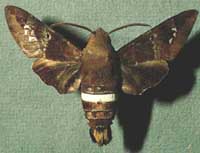 |
The body is dark brown with a wide white
band across the abdomen. Wings are dark brown. The forewing has a
black cell spot and 3 white spots near the pale brown marginal
area. rare |
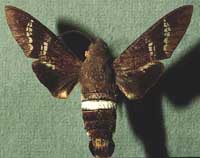 |
Aellopos fadus
USGS/AG, the Fadus Sphinx:
The body is brown with a wide white band across the abdomen. The
upperside of wings is dark brown; the forewing has two bands of pale
spots and lacks a black spot (typical of clavipes) at the end of the
cell. The double outer band in its upper half is diagnostic for fadus. rare |
Aellopos fadus, McGregor, McLennan County, August 4, 2011, Ann Gordon.
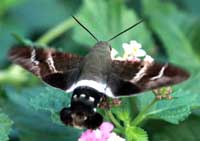 |
The body is dark brown with a wide white stripe across the abdomen.
The wings are dark brown. It is very similar to above species, but the
upperside of the hindwing has
pale patches along the costa and inner margin. rare |
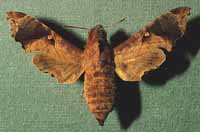
|
Enyo lugubris, the Mournful Sphinx,
MVB:
The body and wings are dark brown. The forewing has a large black
patch covering most of the outer half of the wing. There is a pale
tan cell spot (dark inner pupil), and a fairly straight median line
to the inside of the cell spot.
|
Enyo lugubris,
October 20, 2007, Grey Forest, Bexar County, Michael van Buskirk
 |
This species is sporadically reported southern Texas counties.
Males and females differ.
|
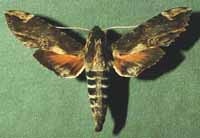 |
Erinnyis lassauxi
VG, the Dominican Sphinx:
This moth flies in Haiti and Jamaica south to Paraguay and Bolivia
with occasional sightings in Texas and Arizona.
This species
is present in southern portions of this region.
|
Erinnyis lassauxi larva, Zilker Preserve, Austin, Travis County,
on talayote (Cynanchum racemosum), a milkweed vine, November 7, 2009, Valerie G.
 |
Erinnyis obscura, the Obscure Sphinx,
USGS:
During the night adults nectar at flowers, including bouncing bet
(Saponaria officinalis) and Asystasia gangetica beginning at dusk.
July and August are flight times in the southern states.
rare
|
See Hemaris comparison to help distinguish
the next two species.
 |
Hemaris thysbe
WO/RKc/MVB, the Hummingbird Clearwing.
It is not difficult to see why many gardeners would mistake an
Hemaris thysbe moth for a small hummingbird as it hovers,
sipping nectar from flowers through a long feeding tube.
generally more eastern species
|
Hemaris thysbe: Michael van Buskirk confirms them in Bexar County, based
on specimens in Roy Kendall collection.
 |
Hemaris diffinis
USGS/ER/AG,
Snowberry Clearwing; Bumblebee Moth.
Adults mimic bumblebees; quite variable. Wings: basically clear, with dark brown to
brownish-orange veins, bases, edges. Thorax golden-brown to
dark greenish-brown. Abdomen: dark (black) with 1-2 yellow segments before tip.
|
Hemaris diffinis ovipositing on honeysuckle, Killeen, Bell County, May 4, 2011, Eric Runfeldt.
Hemaris diffinis, McGregor, McLennan County, July 25, 2010, Ann Gordon.
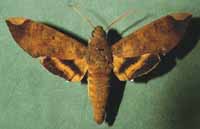 |
Pachylia ficus, the Fig Sphinx,
USGS.
Fw upperside orangish brown with a paler patch along the costa at the tip. The hindwing upperside
is orange to orangish brown with a black outer border, a
black median band, and a white spot on the outer margin near the body.
|
Philampelini tribe:
 |
Eumorpha achemon
USGS, the Achemon Sphinx:
Larvae get large and feed on grape vines and Virginia creeper.
Note the differences between this moth and the Pandorus Sphinx. |
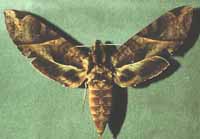 |
Eumorpha anchemolus
USGS,
the Achemon Sphinx:
The moth's upperside is dark brown. The forewings have diffuse white
markings, a white patch near the center of the inner margin, and a
single dark spot at the end of the cell.
rare stray |
 |
Eumorpha fasciatus
USGS, the Banded Sphinx:
The upperside of the moth is dark pinkish brown. Each forewing has a
lighter brown band along the costa, and sharp pinkish white bands and
streaks. Larvae feed upon primrose-willow, Ludwigia (water primrose)
and other plants in the evening primrose family.
|
Eumorpha fasciatus: Michael van Buskirk reports larvae in
Bexar County. No adults seen at lights.
 |
Eumorpha pandorus
USGS/AG, the Pandorus Sphinx:
If you have Grape or Virginia Creeper nearby, then you probably have
this species.
I often get asked to identify larvae from areas not
previously reported.
generally more eastern species |
Eumorpha pandorus, McGregor, McLennan County, September 30, 2010, Ann Gordon.
Eumorpha pandorus, Rockland, Milam County, July 20, 2014, Jeremy Sanders.
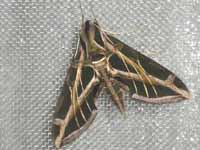 |
Eumorpha vitis
USGS/Amy Smith/AG,
the Vine Sphinx:
The upperside of the moth is dark pinkish brown. Each forewing has a
lighter brown band along the costa, and sharp pinkish white bands and
streaks. The hindwing has a pink patch on the inner margin.
Note large brown parallelogram between lowest striga
up to transverse lines.
|
Eumorpha vitis, Bulverde near San Antonio, Bexar
County, Amy Smith, October 5, 2005
Eumorpha vitis: Michael van Buskirk, Helotes, Bexar County, common,
March-October, eggs on Vitis incisa.
Eumorpha vitis, northeast side of San Antonio, Bexar County, Paul (PT) R. Taylor
and Jennifer Marez, August 18, 2010
Eumorpha vitis, San Antonio, Bexar County, Robert Breeze, May 14, 2011
Eumorpha vitis, San Antonio, Bexar County, Ola Hudgins, July 20, 2011
Eumorpha vitis, McGregor, McLennan County, July 31, 2010, Ann Gordon.
Eumorpha vitis, San Antonio, Bexar County, Beth Fortin Trudell, July 17, 2012
Eumorpha vitis, Rollingwood, Travis County, August 30, 2012, Deborah Wilson.
Eumorpha vitis, Round Rock, Williamson County, July 29, 2014, Texactor.
Macroglossini tribe:
 |
Amphion floridensis
USGS/AG/DW,
the Nessus Sphinix:
This day flier is widely distributed. If you have Virginia Creeper, you
probably have the Nessus Sphinx. Two bright, distinct, narrow yellow
bands are often visible on the abdomen.
|
Amphion floridensis, McGregor, McLennan County, March 3, 2011, Ann Gordon.
Amphion floridensis, Austin, Travis County, May 14, 2011, Deborah Wilson.
 |
The lower wings of this hawkmoth are a solid brownish-orange,
matching the body colour.
You will often see this species listed as Darapsa pholus,
especially in older literature. |
Darapsa choerilus: Michael van Buskirk,
Bexar County, May 2006.
Darapsa choerilus, McGregor, McLennan County, July 10, 2010, Ann Gordon.
 |
Darapsa myron USGS/AG, the Virginia Creeper Sphinx or the Grapevine Sphinx
If you have the
foodplants indicated in the common names, you probably have this
species nearby. The lower wings are orange. |
Darapsa myron, McGregor, McLennan County, September 10, 2010, Ann Gordon.
 |
Deidamia inscriptum
MVB,
the Lettered Sphinx:
The moth's outer margin of the forewing is deeply scalloped.
The upperside is light brown with dark brown markings.
There is a small black and white spot near the tip.
Grape (Vitis), ampelopsis (Ampelopsis), and Virginia creeper
(Parthenocissus) all serve as larval hosts. |
Deidamia inscriptum March, 15, 2008, Bexar Co.,
Michael van Buskirk.
 |
Hyles lineata
USGS, the White-lined Sphinx
This species has
strong migrating tendancies from much further south.
There are records from New Hampshire and Maine. |
Hyles lineata, San Antonio, Bexar County, May 15 2007, Steve Schwartzman
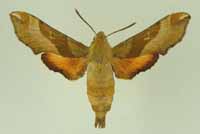 |
The rare and possibly endangered Proud Sphinx flies from Texas and
Louisiana east to northern Florida, north to Alabama, Missouri,
northern Georgia, and South Carolina. rare
|
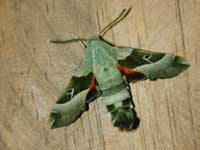 |
The upperside of the forewing is pale gray-green with a deep
green-brown median area and a white dash at the wing tip.
rare
|
 |
This moth is very much under reported across the United States. It
is a rapid day flier so is probably not in too many collections.
Grape is a popular larval host. generally more eastern species
|
 |
Xylophanes tersa
USGS/AG,
the Tersa Sphinx:
The upperside of the forewing is pale brown with lavender-gray at the
base and has dark brown lengthwise lines throughout. The upperside of
the hindwing is dark brown with a band of whitish, wedge-shaped marks.
|
Xylophanes tersa, McGregor, McLennan County, July 28, 2010, Ann Gordon.
|
|
|
